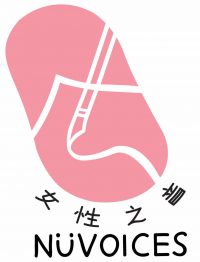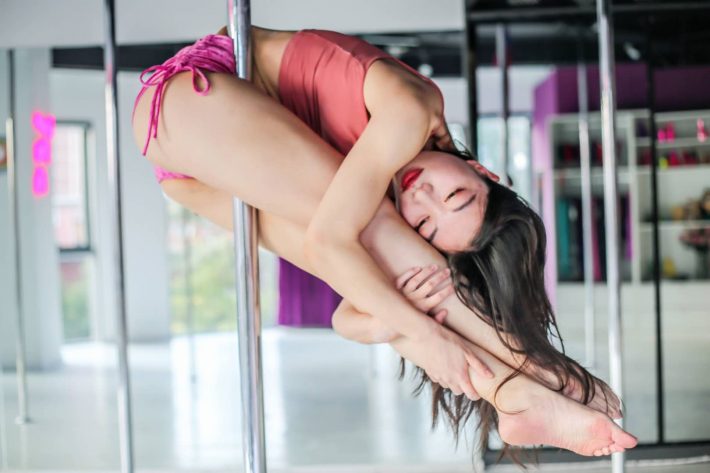BY ROCHELLE BEIESDORFER
When you think of pole dance, what springs to mind? For many, probably scenes of dimly lit clubs and strip teases. But in fitness centers and dance studios around the world, the paradigm is shifting towards a more positive concept: pole dance as fitness, pole dance as body positivity. One such place is China, where performing acrobatic feats on vertical poles has been around since the Song Dynasty.
Alongside India’s Pole Mallakhamb, pole acrobatics have been performed in China for centuries, with reports of pole’s presence as a constant in China’s circus repertoire going as far back as before the 12th century. Called Chinese pole, this gravity-defying gymnastics originally was performed solely by men. Today both men and women somersault, twist and flip themselves between two steel poles that can be up to 29.5 feet (9 meters) tall and have a diameter as thick as 4 inches, according to The National Institute of Circus Arts Australia. To help eliminate any friction between skin and pole, performers in China were traditionally fully clothed. Unlike Chinese pole, modern pole dance—that requires exposed skin to help with adhesiveness—is a rather new phenomenon in China.
First appearing in China’s fitness circuit less than a decade ago, pole dance –sometimes referred to as pole fitness, or pole sport—has been picking up speed in many Chinese cities as an accessible fitness option that encourages body positivity. Annette, co-founder and a certified pole dance instructor at Skyline Dance Lab in Beijing, spoke to me through WeChat about the current status of pole dance in China: “It’s an emerging niche sport. (A) decade ago, there were only a few professional, competition-driven pole training facilities nationwide. Now you can find, not only in 1st-tier cities but also in 2nd and 3rd-tier cities, more and more commercial studios like ours where people come for a fun workout.”
A fun workout indeed, but also strenuous and demanding. Pole dance requires great physical and mental exertion, as well as a high degree of flexibility, according to the Global Association of International Sports Federation (GAISF). Students at Skyline Dance Lab couldn’t agree more. “Pole dance is really great,” said dance student Zhao Lu, PhD candidate studying economics and a partner in a Beijing consulting firm. “Because pole dance requires physical strength, flexibility, and carries a little bit of danger, you need to really concentrate all your attention. The process has a sense of achievement similar to 打怪升级 ( dǎ guài shēngjí ),” she says, making comparison to the feeling of accomplishment one receives when levelling up in a video game.
Body positivity in China’s pole dance community is important when considering the negative effects of sexist Chinese beauty standards, which have been exacerbated by technologies like photo-editing apps. Modern-day pressure to be thin and pale are the ideals that women are bombarded with on a daily basis. Indications of how harsh such requirements are can be seen in the types of hashtag challenges that trend on the popular microblogging platform Weibo. Since 2016, there have been challenges asking women to compare their waistline to a piece of paper ( #A4纸腰# ), equate their thighs to an iPhone ( #iphone6腿# ), highlight how skinny they are by placing coins in their collarbones (#锁骨放硬币#), or, most recently, showcase how petite they are by trying on Uniqlo’s children’s collection (#成人试穿优衣库童装#).
But, there are two sides to every coin, and within the last few years the concept of self-love and body positivity has been gradually gaining traction in China. Women are speaking out and pushing back against discrimination and unrealistic beauty standards. This can be seen on social media with hashtags that question and reject sexist beauty standards, such as #拒绝body shame# , 强调#body positivity# , #身体自爱# and #女性不该只有白幼瘦# (women shouldn’t just be pale, naïve and thin).

Within the small community of pole dancers, many have experienced similar mental shifts towards body positivity and self-love, which they credit to the art of pole dance itself. Various academic journals, books, dissertations and media articles have discussed the direct effect that pole dance has on an individual’s body image and self-confidence.
When asked about what impact they think pole dance has on their self-image and self-love, students at Skyline share similar sentiments. “I think pole dance does help with body positivity,” explains Yoanna, an office worker who started lessons last year. “Every time you do a move, you are learning about your body and challenging what you can’t do. When you practice, you discover: ‘Turns out my body is able to do these (movements).’ Then, you will feel: ‘Wow, I can do this! I’m so cool! My body is beautiful!”
Both Yoanna and Zhao agree that pole dancing has helped them build confidence and become more comfortable in their own skin. “From my point of view, this makes me feel good and that is enough,” Zhao said. “I feel like pole dance brings with it a positive attitude and has benefits that I implement while doing other things.”
Pole novices aren’t the only ones asserting the sport’s positive influence on self-esteem. Professional pole dancers in China have equally voiced these sentiments during interviews. For instance, Sun Jian, a construction-worker-turned-pole-dance-powerhouse from Guangzhou, acknowledges in an interview with ArrowFactory Doc, an independent Chinese media outlet, that pole dance helped him realize his self-confidence and instilled in him a sense of accomplishment. He hopes that pole dance can one day become a commonplace sport in China, and that old biases about pole dance as a vulgar or obscene practice can be reformed.
While there are still stigmas against pole dance, perceptions are changing, as this sport and aerial dance form gains more exposure through popular talent shows and social media. Students at Skyline have also noticed an apparent shift in perspective within their social circles. “I regularly post videos on (WeChat) Moments and the comments I receive are all like: ‘Wow, how awesome!’” Zhao said. “I’ve had a few friends see my videos and then want to come study pole dance.”
Wang Yuan, a financial worker in her early forties who has been studying pole at Skyline for over two years, agreed. “My group of girlfriends all consider this to be like running, swimming, etc.” she said. “They all think pole dance is amazing.”
Along with the reexamination of pole dance as taboo, the judgment that pole dance is only for women is also slowly being upended. According to Annette, it’s a challenge to encourage male participation, with many men still seeing it as a “feminine” sport. “We usually see less than five men try out the classes per year,” she explains. “One or two end up buying a package for further training. Unfortunately, very few stay.”
Yet things are changing. In a video interview with Inkstone, Sun Jian said that while many men initially see pole dance as bizarre, more are signing up. About a third of Sun Jian’s students are male, and this notion of pole dance as a women’s-only club is gradually being overturned.
Li You, a software engineer and one of the few regular male students at Skyline Dance Lab, described to me over WeChat his initial reaction when his wife, a pole dance instructor herself, tried to convince him to give pole dance a try: “At first, I refused, thinking this isn’t an exercise that is suitable for men,” he said. “Later, her brainwashing was successful.” Since beginning pole dance due to his wife’s encouragement over two years ago, Li You has seen improvement in both his physique and sleeping habits.
Shifts in opinion can arguably be credited to how prolific pole has become as an athletic, competitive sport. Every year China hosts numerous competitions at the national and, occasionally, international levels. Internationally, pole as a competitive sport currently holds Observer Status with the GAISF. After achieving Membership Status, pole sport has the potential to become an official Olympic sport. But, since its inception in China, pole dance has been trained for as if it has already obtained Olympic status, with members of a national team diligently training round-the-clock and subjecting their bodies to excruciating pain in pursuit of becoming more flexible and nimble.
With more and more people from all walks of life trying their hands at pole dance in fitness venues across China, the artistry of this gravity-defying fitness option and dance style is gaining widespread appreciation, allowing the innate strength and beauty of the human body to shine through.
About the author
Rochelle Beiersdorfer is a young professional who feels most at home exploring the hutongs of inner Beijing. Previously, she has written professionally about contemporary Chinese culture and Mandarin Chinese for past employers, study abroad organizations and China-focused media outlets. Since 2012, she has been an active supporter of Beijing’s independent, underground music scene and, since the beginning of the COVID-19 pandemic, has offered her skills as a competent, engaging writer to various China-focused media groups. When not writing, Rochelle enjoys spending time pole dancing, traveling around China, exploring China’s craft beer industry with friends, rocking out at music gigs, learning new things, and studying Mandarin Chinese and its dialects. To check out more of Rochelle’s writings, please either visit her website or follow her on Twitter, Instagram and Weibo (石阴影).

